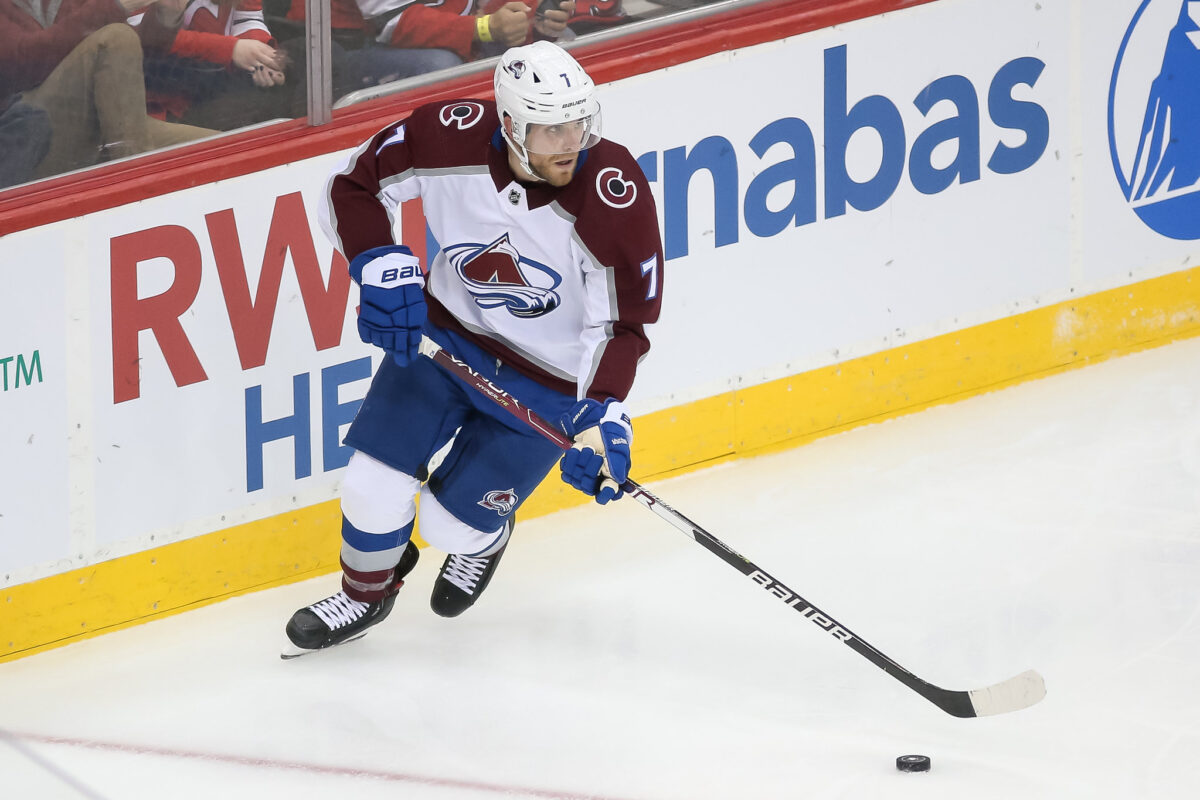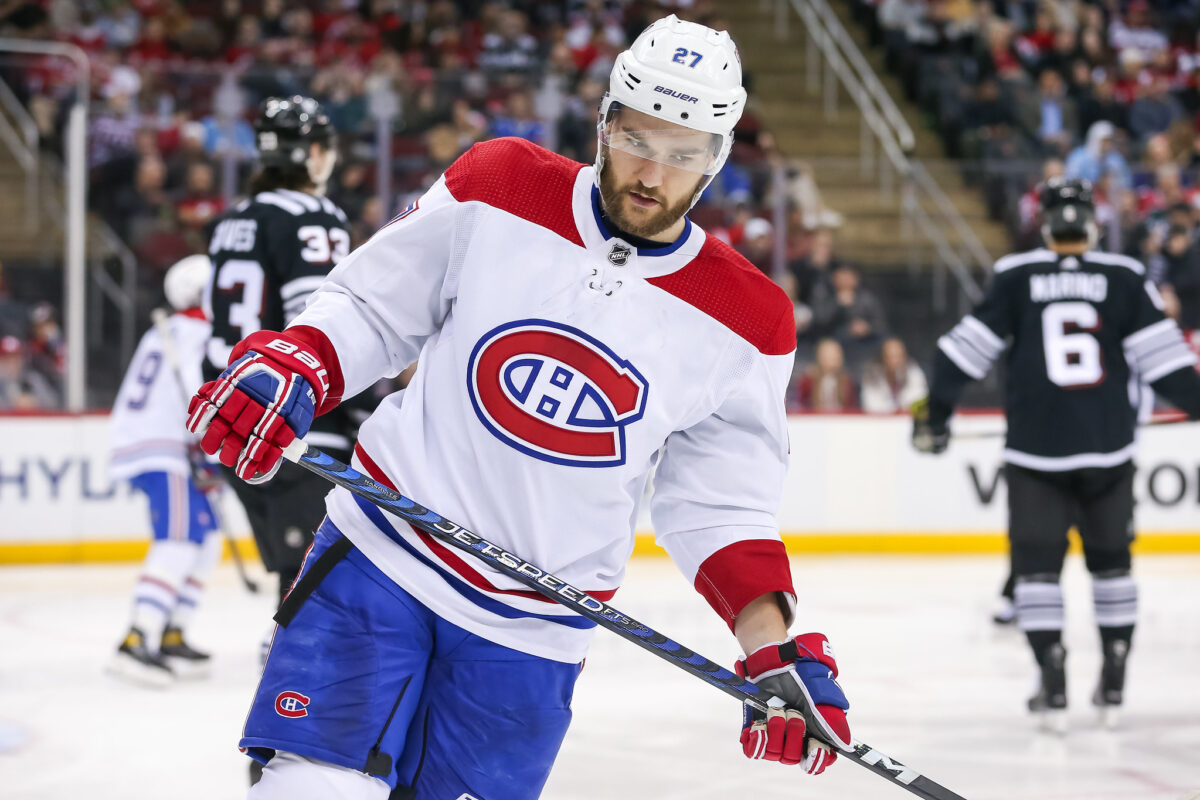Though several notable free agents remain on the market, the Colorado Avalanche have taken care of their most important pieces of offseason business, including acquiring a second-line center in Ryan Johansen. Arguably the most significant transaction took place on July 1, when the Avalanche and 22-year-old defenseman Bowen Byram agreed to a two-year contract carrying an average annual value (AAV) of $3.85 million.
Let’s dive into what the contract could mean for Byram’s future with the Avalanche, and how it could have significant ramifications on the rest of the Avalanche’s roster going forward, particularly on the blue line.
Byram’s Bridge Deal Could Cost the Avalanche
Though the bridge deal secures the blossoming defender’s services through the 2024-25 season, it kicks discussions around a more expensive, long-term contract down the road. Considering Byram has already scored at a 47-point pace over his first three seasons, it’s a decision that could prove much more costly if he takes the next step in his development and sees a jump in ice time for the following two campaigns.
For example, Evolving Hockey’s contract projections are calculated by considering a number of variables, with more weight given to factors such as counting stats which are likely to increase with greater usage. If Byram plays a full season, is deployed more frequently at both even strength and the power play, and alongside more offensively talented teammates, it’s not unreasonable to imagine that his boxscore numbers also skyrocket.

The Avalanche are likely hoping that the salary cap will increase enough by the 2025 offseason that a lucrative Byram extension can easily be slotted into the team’s cap structure. According to league sources, it could rise to as high as $92-93 million for the 2025-26 season which would represent nearly a $10 million jump over the next three seasons (from ‘How and why the NHL salary cap could still see a larger increase this offseason’, Joe Smith – The Athletic, 6/8/23).
As the continued negative impact of the COVID-19 pandemic has shown, projections can be rendered meaningless at a moment’s notice. However, assuming the NHL operates without interruption for the next few years, many cap-strapped teams like the Avalanche could be given a lifeline.
Even while accounting for steady growth in the cap, general manager Chris MacFarland will be staring down a roster conundrum as soon as the 2024 NHL Trade Deadline, with a crowded blue line suddenly demanding a solution.
Avalanche Facing Looming Cap Crunch
Such a turn of events could force the Avalanche to either trade one of Devon Toews, Samuel Girard, or Josh Manson, or let their contracts expire when the time comes. Toews (age 27) will earn $4.1 million against the cap next season but is slated to hit unrestricted free agency (UFA) during the 2024 offseason. Girard’s (25) contract carries a $5 million contract for the next four seasons (through 2026-27) when he also becomes a UFA. Manson (31) accounts for $4.5 million against the cap through the 2025-26 campaign.
CapFriendly projects the Avalanche to have committed $65.775 million to 12 players for the 2024-25 season, leaving them with approximately $22 million to fill out the rest of the roster. That’s also without a potential mid- to long-term deal for newly acquired center Ross Colton (who could command between $3-4 million on his next deal) and the anticipated return of Gabriel Landeskog and his $7 million cap hit.
It should be noted that winger Mikko Rantanen and starting goaltender Alexander Georgiev also require new contracts for the 2025-26 season and beyond, both of which could come with hefty raises. It’s going to take some maneuvering, but fitting all of those contracts can be done if some sacrifices are made on the blue line.
Avalanche Must Choose Between Girard, Manson, and Toews
Though Girard has become a frequent whipping boy for his lack of physicality and occasional miscues, he’s arguably the most valuable asset on the Avalanche blue line. He’s locked up through his prime at a manageable cap hit and like Toews, is an understated contributor to Colorado’s transition game. This could also make him a likely piece of trade bait, but teams need to find as much surplus value as possible when constrained by a hard cap ceiling.
You may also like:
- Colorado Avalanche Won’t Be Contenders This Season
- Colorado Avalanche Lineup Projection for 2024-25
- Avalanche Giving Nikolai Kovalenko a Chance to Prove Himself
- 3 Avalanche Players With the Most to Prove in 2024-25
- Peter “Foppa” Forsberg: A Biography
For my money, Manson is the one who should be traded to create cap room. While he does offer a contrasting style to a famously puck-loving defensive group, he turns 32 prior to the start of the season and will be under contract through his age-34 season. He’s also prone to penalty trouble as is evident by his minus-8 penalty differential from last season, and his minus-16 in 2021-22 (12th-worst among all defenders). Teams will pay up for someone of his ilk, so it’s best to derive some value before his on-ice play falls off a cliff.
The most difficult decision to be made is regarding Toews’ future with the Avalanche. At age 29, the defenseman is moving out of his prime and will be seeking a contract for the downswing of his career. There have been many cautionary tales around the NHL about avoiding long-term commitments for players past their best-before date, and loyalty and nostalgia shouldn’t cloud their judgment when it comes to negotiations.

Toews has been an unsung hero of Colorado’s recent string of success, anchoring the team’s top pair alongside Cale Makar and allowing his free-wheeling partner to do what he does best while fulfilling their collective defensive obligations. He’s posted consecutive 50-point seasons and has accumulated 30 points in 37 playoff games over his Avalanche tenure.
Corey Sznajder’s micro-stat tracking data paints Toews as one of the NHL’s best defensemen at successfully completing transitions out of the defensive zone and protecting the blue line against zone entry attempts. The value of those traits doesn’t necessarily show up on the scoresheet, but they’re just as crucial for winning hockey games.
Working against the Avalanche are Toews’ potential comparables. Of many active players, I’ve noted five defensemen who could serve as a touchstone in contract negotiations, with their age from the first year of their contracts.
| Player | Age | Cap Hit | Term |
|---|---|---|---|
| Darnell Nurse | 27 | $9.25 million | 8 |
| Seth Jones | 27 | $9.5 million | 8 |
| Alex Pietrangelo | 30 | $8.8 million | 7 |
| Dmitry Orlov | 32 | $7.75 million | 2 |
| Hampus Lindholm | 28 | $6.5 million | 8 |
Unless Toews feels extraordinarily generous, the Avalanche have to be cursing the timing of the NHL’s projected cap jump. Of these five defensemen, only Pietrangelo, Jones, and Lindholm have ever cleared 50 points in a single season, and only Pietrangelo and Orlov have ever played a key role on a Stanley Cup champion. Only Pietrangelo has done both and due to being the same age at the time of their new deals, will likely be a key comparable for Toews.
Lindholm’s $6.5 million cap hit is the lowest on this list, but it came off of a string of disappointing seasons for the Anaheim Ducks. If Toews asks for that much at minimum, that represents a $2.4 million raise that must be accounted for next season.
Regardless of age and potential reluctance to sign an older player to a huge deal, it’s difficult to see Toews getting a contract worth less annually than Orlov, especially if he opts for a shorter four- or five-year deal instead. That introduces around a $4 million spike that would require a more drastic solution such as a trade, although there are alternatives.
Avalanche Have Potential Solutions to Cap Issues
Beyond trading one of their defensemen, the Avalanche could sidestep the upcoming cap crunch by committing to a stars-and-scrubs approach, handing out cheap, short-term deals to players looking to rehabilitate their value or to those in need of a change in scenery.
It’s a path they’ve taken before with Toews and Russian winger Valeri Nichushkin and have done so once again this offseason by signing forward Jonathan Drouin. Those moves aren’t always guaranteed to work out (see Ryan Merkley and journeyman forward Alex Galchenyuck), but betting on being able to reinvigorate a depreciated asset is worth a gamble in their situation.

Another option is to turn to their prospect pool, even as it’s slowly been depleted while the team has bolstered its pursuit of the Stanley Cup through a number of trades. The likes of Sean Behrens and Sam Malinski are currently marinating in the system and could act as inexpensive reinforcements in upcoming seasons. Behrens is facing another season in college and time in the American Hockey League (AHL), but Malinski could force himself in as soon as this year with a strong training camp or by bursting out of the gates in the minors.
The NHL’s salary structure creates cap casualties for everyone at some point down the line, and the Avalanche will not be exempt from the pain. It’s a reality that comes with good players eventually demanding compensation in line with their on-ice value, but it’s also a problem that means teams have seen some success with extended postseason runs. If players leave for well-deserved paydays after another Stanley Cup run, so be it. That’s the cost of doing business in a cap world.
Avalanche’s Future Blue Line Group in Flux
Regardless of how things shake out, it’s hard to imagine Byram and Makar not taking up residence on Colorado’s blue line for the next decade, health permitting. There is a great deal more uncertainty around their supporting cast, not least of which is due to their age or value as a trade chip.
The Avalanche have navigated similar problems before and their recent run of success was driven in part by identifying hidden gems around the league and giving them a greater role in a favourable environment. Who’s to say they can’t do it again when it’s time to restructure the blue line?
Data courtesy of AllThreeZones, Evolving Hockey, Natural Stat Trick, and the NHL.
